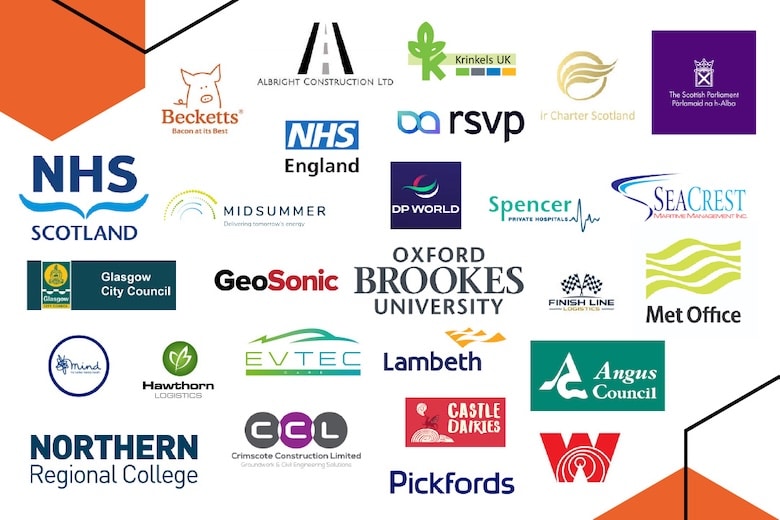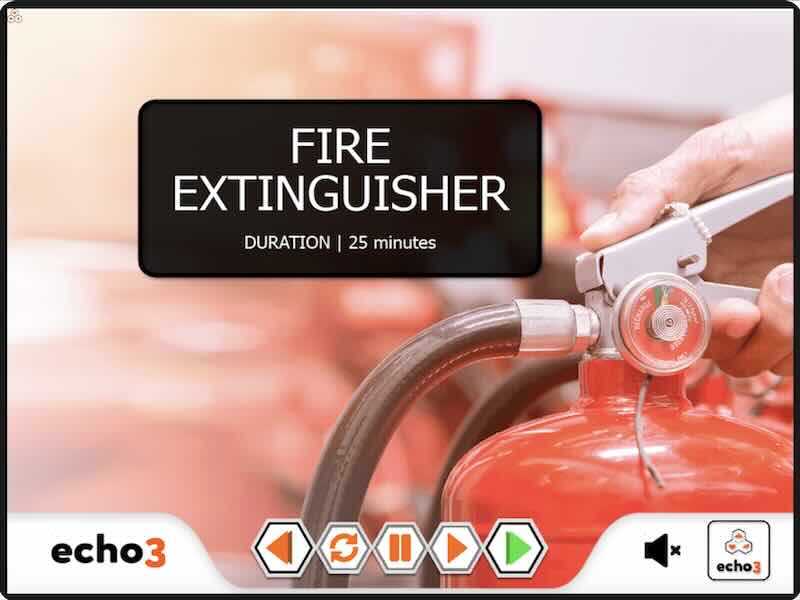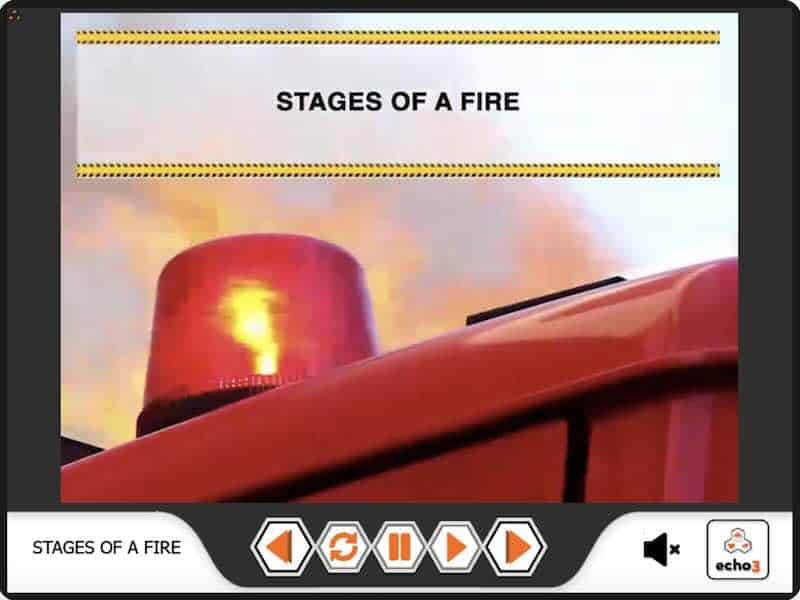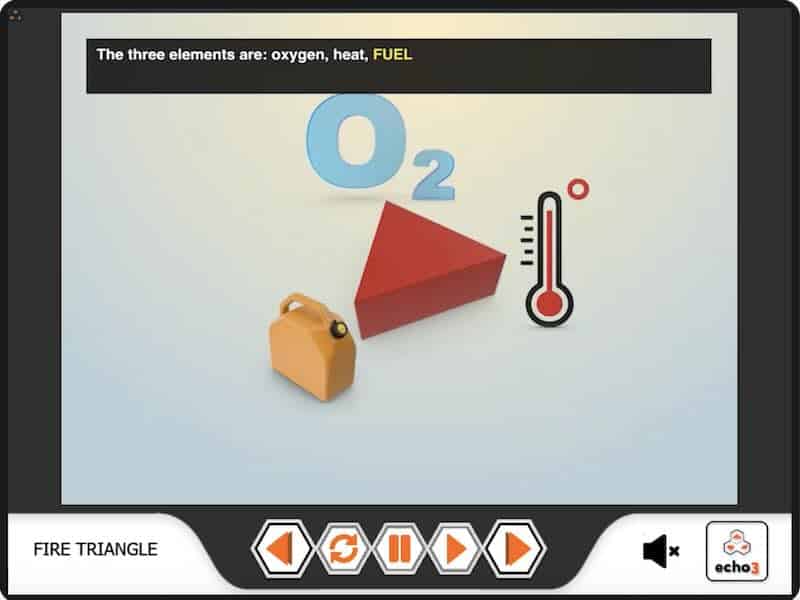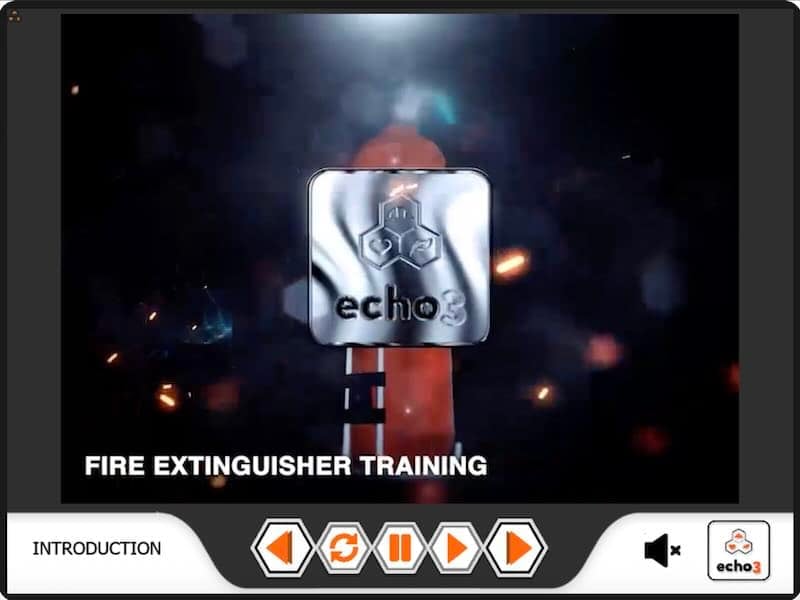Fire Extinguisher Training
This online course provides learners with the essential knowledge to use fire extinguishers safely and effectively in the workplace.
Fire extinguishers can prevent small fires from escalating into serious incidents—but only when used correctly. For example, using a water extinguisher on an oil fire can make the situation far worse. That’s why proper training is critical.
Under the Regulatory Reform (Fire Safety) Order 2005, all businesses are legally required to provide appropriate firefighting equipment and ensure staff are trained in its use.
In this short but comprehensive course, learners will gain a clear understanding of when it’s safe to tackle a fire, how to choose and operate the correct type of extinguisher, and the basic maintenance considerations needed to keep equipment ready for use.
Upon successful completion, a CPD-accredited certificate is emailed to the learner and securely stored online for employer records.
Fire Extinguisher Course Content
UNIT 1. Introduction
UNIT 2. Fire Triangle
UNIT 3. Stages of a Fire
UNIT 4. Fire Classification
UNIT 5. Types of Fire Extinguishers
UNIT 6. How to Use a Fire Extinguisher
UNIT 7. Fire Extinguisher Inspection and Maintenance
Fire Extinguisher Training Certificate
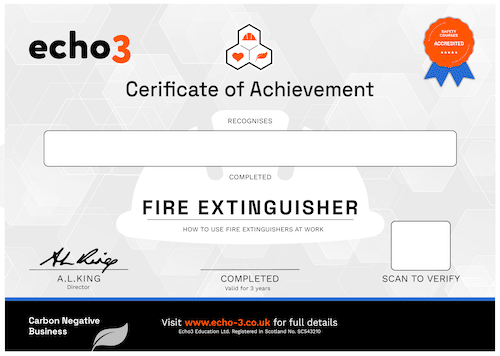
Download and Print Your Certificate
- Written in compliance with the Regulatory Reform (Fire Safety) Order 2005
- Developed by qualified health and safety professionals
- Accredited by CPD – learn more about CPD here
- Last Updated January 2025
- To gain the certificate you must complete the assessment which involves 10 questions.
- The online Fire Extinguisher certificate is valid for 3 years.
Course Preview
Echo3 courses include engaging motion-graphic video content, with full english subtitles
Reviews
How to Get Certified in 3 Steps
Individual Learners


Benefits for Individuals
-
Engaging video-based content
-
Learner dashboard included
-
Instant access after payment
-
Free course retakes
-
Shareable digital certificate
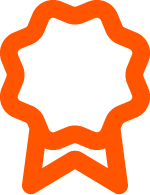 QR Code Certificate
QR Code Certificate




Bulk Buying Discounts
Who should take Fire Extinguisher training?
This Fire Extinguisher training provides the knowledge needed to tackle small fires at work. If you have the requirement to tackle small fires at work then appropriate training is required.
Roles that have this duty will usually be determined during a risk assessment. Often those working as a Fire Warden or Fire Marshal will benefit from this knowledge. Or it may be part of general Fire Safety responsibilities in workplaces where the fire risk is elevated.
What are fire extinguisher course learning outcomes?
Upon completion of this course, you will:
- Understand the fire triangle and its elements.
- Recognise the stages of a fire for effective response.
- Identify the five classes of fires and select appropriate extinguishers.
- Learn about the various types of fire extinguishers and their applications.
- Know the step-by-step process of using a fire extinguisher.
- Comprehend the significance of routine inspection and maintenance.
How are fire extinguishers used?
Proper usage techniques are essential for effective firefighting.
- Pull Pin: Remove the safety pin from the extinguisher. This initial step ensures that the extinguisher is ready for use when needed.
- Aim: Point the nozzle or hose at the base of the fire, not the flames. This targeted approach increases the chances of extinguishing the fire effectively.
- Squeeze: Firmly squeeze the handle to release the extinguishing agent. Applying steady pressure ensures a controlled and continuous discharge of the agent.
- Sweep: Move the nozzle from side to side to cover the fire until it’s extinguished. This sweeping motion helps distribute the extinguishing agent evenly over the fire, ensuring comprehensive coverage.
- Evacuate: If the fire persists or grows, evacuate immediately and alert others. Knowing when to retreat is essential for personal safety.
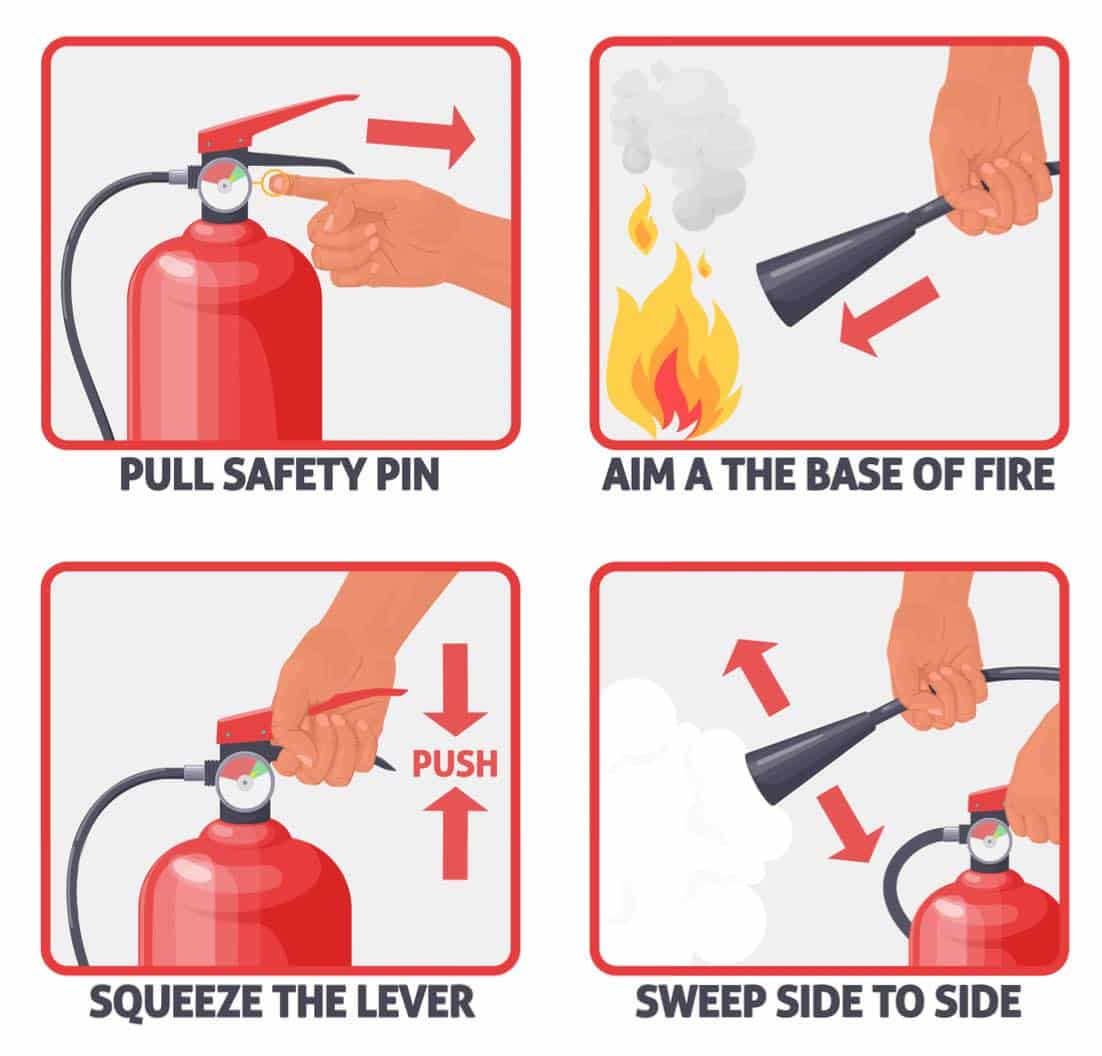
How do fire blankets work?
Fire blankets are crucial tools in many fire safely kits. Whenever fire blankets are present it is essential to understand how to use them effectively. Made from flame retardant material they work by depriving the fire of oxygen and extinguishing the fire. It’s important to remember that fire blankets are designed for small fires only.
Keep in mind trying to tackle larger fires with a blanket can be both dangerous and ineffective. For larger fires it is much better to immediately raise the alarm and evacuate the building.
Fire Blankets are often used for kitchen fires, where oil and grease can fuel flames rapidly. They can also be used for smothering small fires involving electrical equipment or appliances.
Using a fire blanket is easy.
When confrontment with a small fire, remember the acronym PASS. Pull, aim, Squeezer Sweep.
First pull the fire blanket out of its packaging. Then, aim it at the base of the flames, covering them completely. Next, gently squeeze the blanket to release any trapped air, ensuring optimal smothering. Finally sweep the blanket across the flames extinguishing them entirely.
Finally, remember to regularly inspect you fire blankets for signs of damage or wear and replace it as needed to ensure its reliability in an emergency. Ensure a fire blanket is readily accessible to protect your home or business.
What are the different types of fire extinguisher?
Fire extinguishers have red metal bodies with a coloured band to identify their type. There are five types of extinguishers commonly in use for the different fire classes.
Carbon dioxide
These extinguishers have a black band and a black funnel shaped hose. Use for electrical, class B and C fires. Don’t use in small rooms.
Water
Water extinguishers have a solid red body. Use on class A fires only.
Dry powder
Dry Powder extinguishers have a blue band. Use for all fires except class F.
Foam
Foam extinguishers have a cream band. Use on class A and B fires.
Wet Chemical
These extinguishers have a yellow band. Use on class A and F fires.
Using some extinguisher types on the wrong fire class may spread the fire.
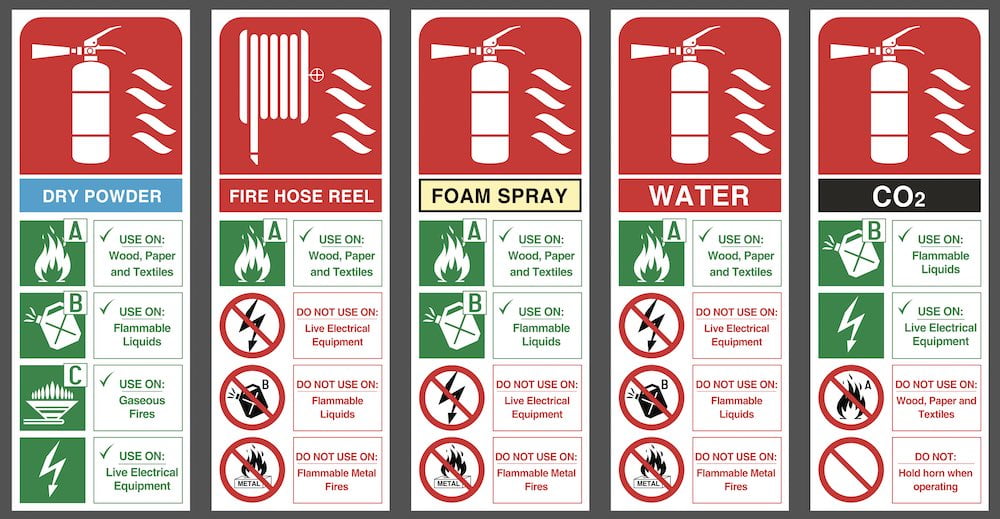
What are the different fire classifications?
Fires are grouped into ‘classes’ based on the fuel they burn. The different classes are called Class A, B, C, D, F and Electrical.
Knowing the class means the correct fire extinguisher can be used.
Class A: Class A fires burn flammable solids such as paper, wood, coal, plastic, furniture, textiles.
Class B: Class B fires burn flammable liquids such as paint, petrol, oil, diesel.
Class C: Class C fires burn gasses such as natural gas, hydrogen, propane and butane.
Class D: Class D fires burn metals such as potassium, aluminium, and magnesium.
Class F: Class F fires are fires that involve cooking oils and fats. Fires of this class can occur in food premises.
Electrical Fires: This type of fire does not have its own class because fires involving electrical equipment can fall into any of the other classes.

Additional relevant training
FIRE AWARENESS – Provides staff with an understanding of how to reduce the chance of fires and mitigate their impact in the unlikely event they do occur.
FIRE MARSHAL OR FIRE WARDEN – How to safely undertake the duties of a fire marshal or fire warden.
PAT TESTING – Know how to maintain electrical appliances safely to minimise the chance of fires and electric shock. For everyone wishing to undertake PAT Tests.
If you have learners who require multiple courses, you have the option to order CREDIT.



